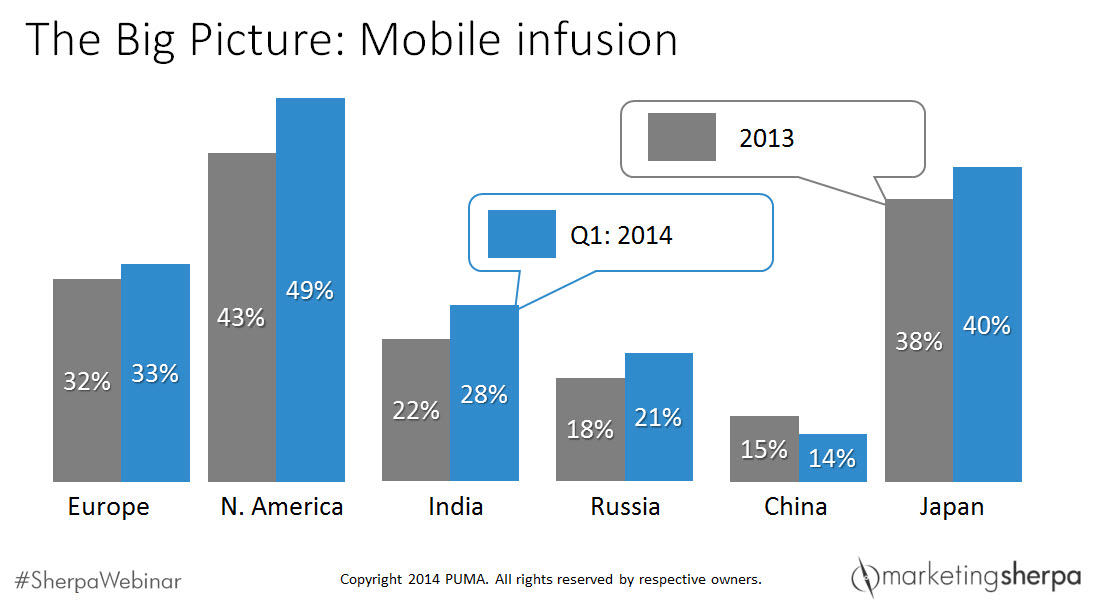Multichannel Marketing: 3 tips to help take your e-commerce global
Achieving e-commerce growth in a global marketplace is tough for any organization.
This is especially true when you consider the increasing complexity of global e-commerce coupled with the challenges of reaching new regional customer bases that are different than your existing customers.
These were some of the challenges facing Tom Davis, Global Head of E-commerce, Puma. In a recent MarketingSherpa webinar, he revealed how Puma used an omnichannel marketing approach to successfully position the company’s e-commerce initiative worldwide.
“I think the biggest thing for us is to identify where we fit in the marketplace,” Tom explained.
In this MarketingSherpa Blog post, we’ll take a look at three tips you can use to help take your e-commerce efforts global.
Tip #1. Love your customer data
According to Tom, diving into your data to discover how your business will operate (and potentially grow) in new regional markets is paramount.
“I think it’s imperative for brands, especially retail brands that may have a wholesale part of their business, to really embrace the data,” Tom said.
Tip #2. Focus on delivering a mobile-first experience to stay ahead of the pack
One interesting point Tom mentioned was how different regional markets are in different stages of smartphone tech adoption, which will, in turn, impact both online user experiences as the mobile migration continues and the organization’s market penetration strategy in different regions.
In sum, there are a lot of smartphone tech adoption opportunities yet to occur in markets outside of the U.S.
Tom also explained that the gray bars are last year’s mobile penetration (percent of unique mobile visitors) for Puma’s Web properties versus the blue bars, which were just for Q1 of 2014.
“You can see that in almost every market, our mobile penetration is growing,” Tom said.
Tip #3. Make sure your house is in order
Optimizing your internal structure to efficiently deliver on a global scale is also key as Tom revealed in the changes Puma made to its internal e-commerce structure to improve positioning to better serve regional markets.
Prior to the shift, Tom explained that before he joined Puma, its e-commerce operation was scattered across multiple teams, marketplaces and third-party platforms.
“It was all over the place,” Tom said. “Which was good maybe 10 years ago, but there was no synergy between any of these teams they were working independently.”
Tom also explained how Puma’s e-commerce realignment utilized a central global hub structure stemmed with core regional markets.
“What we’re trying to do is align ourselves to work with the marketplace, but also be efficient,” Tom said.
To learn more about Tom’s marketing strategy to aid Puma’s growth in global e-commerce, you can watch the on-demand webinar replay of “Omnichannel Marketing: Optimizing digital content efforts to maximize growth in e-commerce.”
You may also like
MarketingSherpa E-commerce Benchmark Study [Made possible by a research grant from Magento]
E-commerce Research Chart: Which channels are companies investing in? [Marketing research chart]
E-commerce: 3 test ideas to optimize the customer shopping experience [More from the blogs]
Mobile Marketing: E-commerce site uses responsive design to achieve an 8% lift in cart abandonment campaign [Case study]
Categories: Ecommerce Eretail analytics, Branding, customer data, ecommerce strategy, global marketing tactics, marketing strategy












